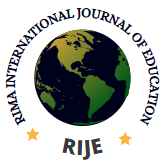Characterising the Patrons of Traditional Maternal Healthcare Services in Southwestern Nigeria
Olasunkanmi Rowland Adeleke
Department of Human Kinetics and Health Education, Adekunle Ajasin University, Akungba Akoko, Nigeria Email: olasunkanmi.adeleke@aaua.edu.ng
Abstract
It is evident that the preference for traditional maternal health care services is a significant component of high maternal mortality in the country. Hence, the need to examine characterising the patrons of Traditional Maternal Health Care Services (TMHCs) in Southwestern Nigeria. The descriptive research design technique approach was used in the investigation. All pregnant women and nursing mothers who visited TMHCs in the Southwest made up the study's population. The sample size was 1020 pregnant women and nursing mothers. Information from the respondents was gathered using a self-made questionnaire. Data was analysed using frequency distribution and charts; ANOVA was used to test the significance of the variables that were measured. The results indicated that low-income earners 378 (43.2%), young adults 718 (82.1%), those who attained tertiary education 322 (36.8%), and traders 344 (39.3%) were the respondents who patronised TMHCs. Also, it showed that factors influencing the patronage of traditional maternal healthcare services did not differ across ethnic groups (F = .373, sig = .688) in the study area. It that factors influencing the patronage of traditional maternal healthcare services differed based on educational status (F=21.193 sig=.000). The study concluded that patronage of traditional maternal services is a predisposing factor to high maternal mortality in Southwestern Nigeria.
Keywords
Faith-based home, indigenous healthcare, pregnant women, maternal death, conventional healthcare
Reference
Adewuyi, E. O. Khanal, V. Zhao, Y. David, L. Bamidele, O. D. & Auta, A. (2019). Home childbirth among young mothers aged 15–24 years in Nigeria: A national population-based cross-sectional study BMJ Open 9:9, Article 95 e025494. https://doi.org/10.1136/bmjopen-0254
Catherine, M. Amardeep, T. Bridget, R. & Amanda, T. (2019). Levels and determinants of maternal mortality in northern and southern Nigeria BMC Pregnancy and Childbirth 19:417.
Gilda, S. Henshaw, S. & Susheela, S. (2017). Induced abortion: estimated rates and trends worldwide. Lancet, 1338–45
Joseph, O. U. Charlotte, B. O. Emmanuel, O. O. & Anthony, O. I. (2019) Factors associated with the use of traditional birth attendants in Nigeria: a secondary analysis of 2015 Nigeria National Demography and Health Survey, NDHS, Nigeria.
Hunt, P. & Bueno de Mesquita J. (2010) Reducing maternal mortality: the contribution of the right to the highest attainable standard of health.2010; England: University of Essex.
Ibrahim, D. O. (2016). Social-economic determinants of maternal mortality in rural communities of Oyo State, Nigeria. International Journal of Scientific Research Publications, 6:9, 280-285.
International Maternal & Child Health Care (2017). A practical manual for hospitals worldwide. Radcliffe Publishing Ltd St Mark’s House Shepherdess Walk London N1 7BQ United Kingdom
National Population Commission [NPC] (2013) . Nigeria demographic and health survey 2013; Abuja, Nigeria and Rockville, Maryland, USA: NPC and ICT International.
Nigeria Demographic and Health Survey (2018). In: National Population Commission.2018; Rockville, MD: Abuja and ICF International. Maryland, USA. Accessed 2021
Nwankwo, O. Ani, O. E. Akpoke, M. & Ugwa, E. A. (2019). Determinants of choice of place of delivery among women attending two referral hospitals in Kano North-West Nigeria. Nigerian Medical Journal. 60(2):68.
Ogbo, F. A. Trinh, F. F. Ahmed, K. Y. Senanayake, P. Rwabilimbo, A. G. Uwaibi, N. E. & Agho, K. (2020). Global Maternal and Child Health Research Collaboration GloMACH. Prevalence, Trends, and Drivers of the Utilization of Unskilled Birth Attendants during Democratic Governance in Nigeria from 1999 to 2018. Int J Environ Res Public Health. 2020; 17:372 382. doi: 10.3390/ijerph17010372. PMID: 31935928; PMCID: PMC6981726.
Ogu, R. N. & Ephraim-Emmanuel, B.C. (2018). Prevention of Maternal Mortality in Nigeria: Journal of Gynecology Women’s Health Public Health to the Rescue; 10:1
Olawale, O. Tomike, I. O. Oluwatobi, J. A. & David, I. (2019). Maternal Mortality and Maternal Health Care in Nigeria: Implications for Socio-Economic Development, J Med Sci. 7(5):849-855.
Ozioma. E. O.J. Chinwe, O. A. N. (2019). Herbal medicines in African traditional medicine. Herbal Medicine 10 :191-214.
Punch Newspaper (2022). Nigeria’s maternal deaths worry specialists, experts recommend adequate care, facilities. 14th August 2022.
Sowunmi, C. O. Olajide, A. O. Akodu, C. O. Sodimu, J. O. & Ajibade, B. L. (2020). Factors influencing patronage of Traditional Birth Attendants (TBAs) among pregnant women attending TBAs centres in Epe, Lagos, Nigeria. International Journal of Nursing, Midwife and Health Related Cases 6(2): 46-56.
The Guardian newspaper. (2018).Traditional birth clinics: Old practice in need of modernization; (29 April 2018)Available at: https://guardian.ng/features/health/traditional-birth-clinics-old-practice-in-need-of-modernisation/amp/
Ugboaja, J. O. Oguejiofor, C. B. Oranu, E. O. & Igwegbe, A. O. (2018). Factors associated with the use of traditional birth attendants in Nigeria: a secondary analysis of 2013 Nigeria national demography and health survey. The Nigerian Journal of General Practice 2018; 16:45-52. doi: 10.4103/NJGP.NJGP_27_17
Vandana, S. Willa, B., Muhammad A. K. Jessica, L. & Martina, B.N. (2017). High maternal mortality in Jigawa State, Northern Nigeria estimated using the sisterhood method. BMC Pregnancy and Childbirth, 17:163 DOI 10.1186/s12884-017-1341-5
World Bank (2022). Population growth (annual %) Nigeria https://data.worldbank.org/indicator
World Health Organisation. (2020). Trends in maternal mortality. 2000 to 2017: estimates by WHO, UNICEF, UNFPA, World Bank Group and the United Nations Population Division 2020; Geneva: World Health Organisation.
World Health Organisation (2019). WHO global report on traditional and complementary medicine 2019; Geneva: World Health Organization
World Health Organization (2017). Maternal and new-born health. Copenhagen: WHO Regional Office for Europe. http://www.euro.who.int/en/health- topics/Life-stages/maternal-and-newborn-health/maternal-and-newborn-health.
World Health Organisation (2018). Estimation, Levels & Trends in Child Mortality: Report 2018; Estimates developed by the United.
World Health Organisation (2018). Estimation, Levels & Trends in Child Mortality: Report 2018; Estimates developed by the United.
World Health Organization. (2010).WHO guidance for measuring maternal mortality from a census. Geneva; World Health Organization.
